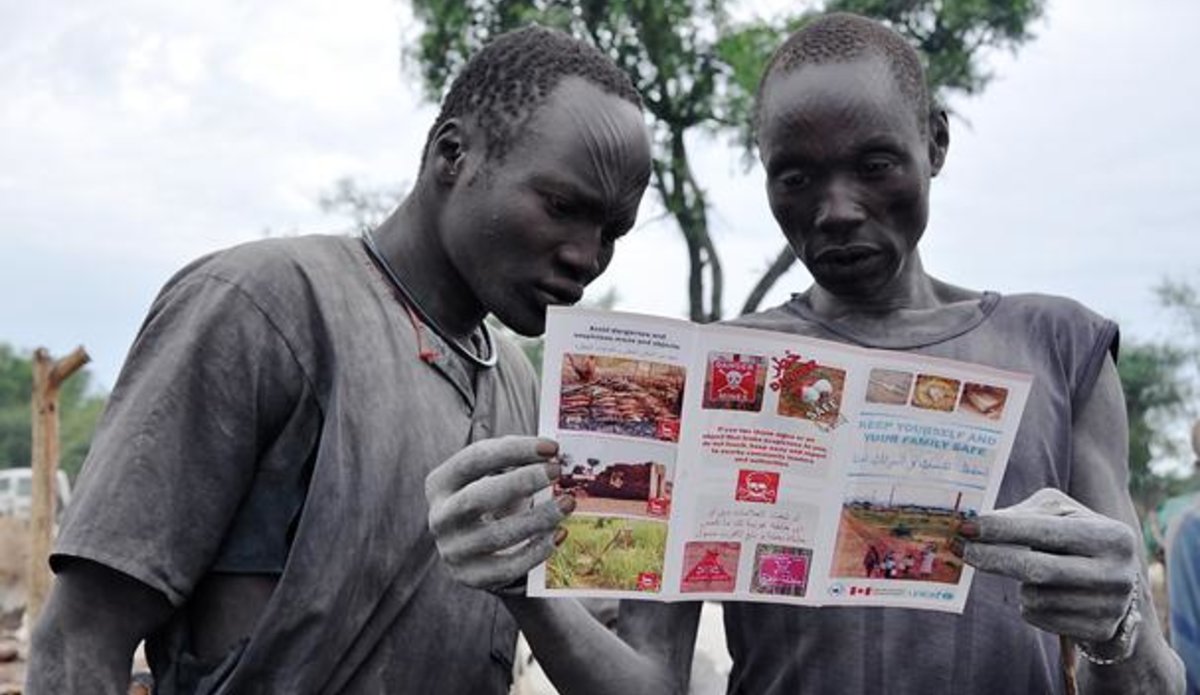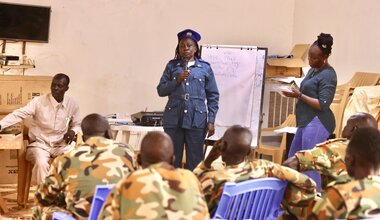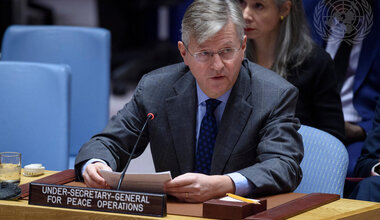Plastic models, stones and mine risks
On a foggy, overcast morning,trainers arrived at a South Sudanese cattle camp in Central Equatoria armed with flipcharts and plastic models of landmines.
The trainers, who work for the local non-governmental organization (NGO) Sudan Integrated Mine Action Services (SIMAS), were coming to speak to a group of nomadic Mundari people about the risks of mines and other explosive remnants of war.
A pastoralist people who are always on the move with their cattle, the Mundari are particularly vulnerable to these risks, as they often travel to unfamiliar parts of South Sudan. For many of the camp's members, this was to be their first formal lesson in the dangers of landmines and unexploded ordnance (UXO).
The three-member team from SIMAS began to set up the teaching area, nimbly weaving between bonfires and dozing bulls as they leaned flip charts against trees and marked the area with painted stones. A crowd gathered, soon swelling to over 80 people.
Edward Kenyi, a SIMAS Mine Risk Education Coordinator, delivered a crisp lecture to the group. As only a few people in the camp could read or write, he relied heavily on visual aids to get his messages across.
Kenyi invited his audience to inspect the materials he had brought. They leaned in for a closer look at the flipcharts, which demonstrated unsafe behavior around unexploded ordnance and showed plastic models of mines and stones painted white on one end and red on the other.
The stones are used by the mine action programme to warn the local population that the land on the red side may be mined.
This was not the first time the camp's members had seen the stones or explosive remnants of war. Many, though, were only beginning to understand what they had seen.
Martin, a herder of about 30 years of age, recalled seeing a mine in the nearby community of Tindolo, but said he did not realize at the time it might be dangerous.
"Now I know what it was," he said.
The UN Mine Action Service (UNMAS) works with partners like SIMAS to spread awareness of the dangers of mines and other explosive remnants of war. To date, mine risk education has been delivered to over 1.8 million people throughout South Sudan.
But when SIMAS first approached cattle-herding groups about risk education, they encountered a lot of resistance.
"They asked many questions – what is your aim here? What do you want?" said Madut Akol Madut, the NGO's Regional Mine Risk Education Coordinator.
It was difficult to gain trust from the closed, traditional communities at first. But eventually they saw the benefit of the lessons.
"Now they ask what to do when they find something that seems dangerous. ... They ask if the mines and UXO will ever get rotten (or) lose their power," said Mr. Kenyi. "We tell them that they last. Sometimes, when they see pictures of children that have become handicapped, they ask whether their children could also get hurt."
The lessons helped communities realize the threat they faced and taught them methods to minimize the risks. In addition, they were requested to inform local authorities when they spotted a dangerous item, thus helping to map hazardous areas throughout South Sudan.
SIMAS launched the mine risk education project last August and plans to continue targeting vulnerable populations in Central Equatoria State until the end of this month.
The project, which is supported by UNMAS, is intended to reach 10,000 beneficiaries, including children and adults in cattle camps, returnees at way stations coming back from Sudan, and other displaced persons.
The education initiatives complement clearance and assessment efforts by UNMAS and its implementing partners. To date, over 27.2 square kilometers of land in South Sudan have been cleared or verified in 2012 as being free of mines, making way for the establishment of schools, health clinics and agricultural projects.
 UN
UN United Nations Peacekeeping
United Nations Peacekeeping





